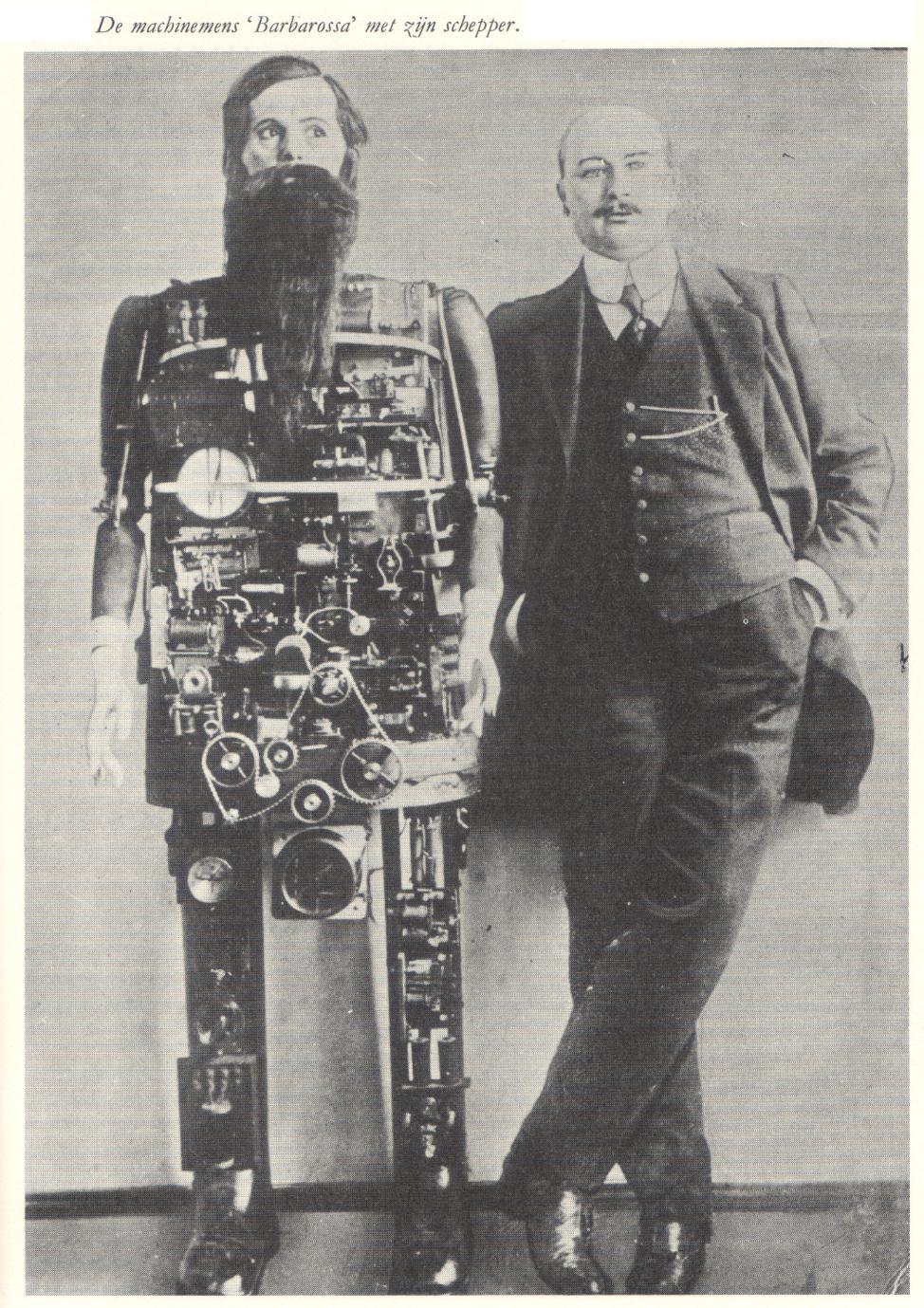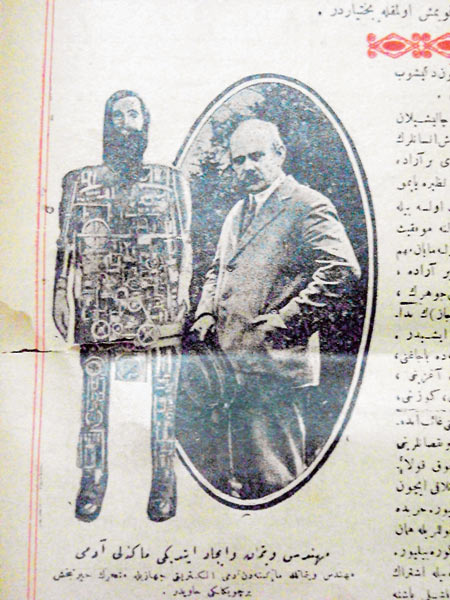1909 – Occultus -also Barbarossa [redbeard]
Very little is known other than a weird photo and article on an automaton / robot named "Occultus" recently exhibited in Berlin by a man named Whitman.
Its quite probable that Occultus can't perform all the functions he's purported to do, but possibly some of them, so I haven't yet excluded him as a fake. See my friend David Buckley's account of him here.
"Radiomensch Occultus" is its German name.
Some other reports have Occultus dated at 1911, but the Syracuse Herald (USA) reported it in 1909.
Herr Adolph Whitman posing with Occultus.

Here's a rather interesting rave – an insight into the times…
The Fort Wayne Sentinel 20 Jun 1914 p13 Occultus
Here He is—the Complete Man-Made Man Who Does Just About Everything
Inventor of the Bonesless, Bloodless, Fleshless Man Sees Ahead When Cog-Wheel Man Will Do All Work for Living People, and Even Do Their Fighting.
Berlin. June 20.— "I hold the world in the palm of my hand: I could be emperor of the universe; I could make the terrestrial globe my personal property! For I've invented an artificial man who could compel all other men to become my slaves!"
So says Herr Adolph Whitman, famous Berlin Inventor. He has constructed of wheels and chains and levers an artificial man who walks, talks, mingles with a crowd just as naturally as any real man would. This machine-man is the outcome of many years laborious and painstaking application of Whitman's wonderful inventive genius.
He calls his mechanical man "Occultus."
"Occultus obeys my every order." says Whitman. "Whether I tell him to run, to turn, to stop, to lift something, to sit down, to sing, whistle or answer question, he obeys implicity and without hesitation. I could walk him into a crowded parlor and he would act so naturally that half the evening might pass before the guests realized that they had a mysterious and occult person among them.
"The secret of making my artificial men is simple. I shall soon be able to construct them by the hundreds in special factories.
"Just imagine what I can do when I begin to turn these mechanical men out by the wholesale. I could organize them into a vast army, and train it to an automatic perfection in military tactics. Then, armed with the most destructive weapons of modern warfare, my hordes on non-killable soldiers could set forth to conquer the continents.
"I could sweep the face of Europe clean in one campaign. Bullets, bombs, shells—my armies would he impervious to them all. Faster than my men fell, I could turn out new ones in my factories."
Whitman could man great navies with his machine-men, and send them forth through all the seas, and subdue all the nations. Shortly he would be emperor of the world.
Or, he could get control of the whole earth in another way — by purchase. For since all wealth is based on human industry, by controlling the inexhaustible industry of the machine-men, he could become the wealthiest man in the world. All the earth's riches he could monopolize, and all production would be carried on in his factories, filled with mechanical men.
Imagine what the new world then would be—humming with every known form of life and industry, and yet made up of only dead machinery! There would be not a ray nor smile of true life on all the globe, yet it would be covered with whirring, clanking, neverstopping mechanism.
The telegraphs, with mechanical men at their sounders, would continue to speak across the continents. Huge vessels would ply the seas, carrying freight and artificial passengers from port to port. Great areas would he built up into cities of towering skyscrapers whose streets would throng with machine-men, tramping back and forth on the multitudinous affairs of their life, And in vast factories they would be continually turning out new mechanical men by the wholesale!
There is nothing that a civilization of such men could not accomplish, for they would fear none of the chief obstacles of modern industry -disease, suffering and death.
"But of course I shan't attempt to bring about any such destruction of hunanity. Instead, I hope in time to perfect my machine-men so as to make them a great boon to humanity," says Whitman.
In time, his machine-men could be made into a race of slaves, supporting in case all natural mankind. Each human being would have as many servants as he liked. No one need do a stroke of work other than give orders to his mechanical serfs. Every bit of mining, manufacturing, all the dangerous and disagreeable labors of civilization would be turned over in the unfeeling machine-men. And we humans would live in ideal luxury.
"It would be the realization of the millennium!"
SanAntonioLightandGazette 23 Apr 1911 p34 Occultus
A Clockwork Man That Talks and Sings.
H.[err Adolph] WHITMAN, a Berlin Inventor, has, after many years, succeeded in making a mechanical man that can walk, and make other human movements, and can speak, sing, whistle and laugh.
This mechanical masterpiece is so human that at a distance of a yard it cannot be told from a living being. The figure is a mass of intricate cogs and machinery.
In the chest a number of phonographs are arranged, but how the machinery is controlled is a secret of the inventor. It has been said that wireless electric waves are at the bottom of the mechanical miracle. Each part of the figure is controlled by a little electric motor.
The inventor carries about with him a disk, upon which is a little needle. This ia attached to an electric coil of his own invention, which is in harmony with the little motors inside of the figure. By moving the needle from one point to another, he starts by wireless waves he parts that he wants to move. And this principle is worked out in endless combinations.
The invention seems in fact to duplicate Bulwer Lytton's mechanical servants in his famous story "The Coming Race," and at a latter date H. G. Wells's conception of the same solution of the servant problem.
Writers of fiction, in all countries and ages, have found inspiration in the Idea of duplicating the complicated works of nature with mechanical constructions.
To describe such imaginary mechanisms is much easier than actually to construct them.
Clockmakers, owing to their familiarity with the means of producing all sorts of movements in the transmission of power, have always been the most ingenious artificers on these lines—but they have usually connected their moving human figures with the main purpose of their contrivances—to tell the time of day and the progress of the seasons.
To construct a mechanical man is merely to triumph over mechanical difficulties—the man being of no use, but merely a curiosity when created—which appears to be the case with Mr. Whitman.
ALAMET – MISNOMA
There is currently a Turkish story going around that Occultus / Barbarossa is an early Ottoman empire robot built as a gift for the Japanese, under the name of Alamet . An early Turkish paper shows this robot with Gernsback's Robot Soldier. A misassociation has been made somewhere.



I cannot see any resemblance between the two mechanical men – they are not the same.
Probably Occultus is capable of walk but probably cannot do semazen activity. So probably second photo is not related with Alamet. First picture, at left, is an illustration of the Alamet.
Capabilities of Alamet
Can 0.5 meters walk and do Samazen activity
While doing Samazen, skirt of Samazen dress opens up abit(as in a whirling man.)
Carrying ezan(is way of call people for prayer with defined holy words) using phonograph.
After all is done returning back to its original position and then sitting.
Doing all this in every hour
setting up robot every week.
Hi Orcun, As I said in my blog, I believe someone has picked up Whitman’s photo of his mechanical man (with electric motors, solenoids, relays, batteries, etc) and attributed it to what they think Alamet looks like (all clockwork)! The mistake is being propagated. Reuben.